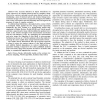Free Online Productivity Tools
i2Speak
i2Symbol
i2OCR
iTex2Img
iWeb2Print
iWeb2Shot
i2Type
iPdf2Split
iPdf2Merge
i2Bopomofo
i2Arabic
i2Style
i2Image
i2PDF
iLatex2Rtf
Sci2ools
PAMI
2011
2011
Decoupled Active Contour (DAC) for Boundary Detection
— The accurate detection of object boundaries via active contours is an ongoing research topic in computer vision. Most active contours converge towards some desired contour by minimizing a sum of internal (prior) and external (image measurement) energy terms. Such an approach is elegant, but suffers from a slow convergence rate and frequently mis-converges in the presence of noise or complex contours. To address these limitations, a decoupled active contour (DAC) is developed which applies the two energy terms separately. Essentially, the DAC consists of a measurement update step, employing a Hidden Markov Model (HMM) and Viterbi search, and then a separate prior step, which modifies the updated curve based on the relative strengths of the measurement uncertainty and the non-stationary prior. By separating the measurement and prior steps, the algorithm is less likely to mis-converge; furthermore, the use of a Viterbi optimizer allows the method to converge far more rapidly than ene...
| Added | 14 May 2011 |
| Updated | 14 May 2011 |
| Type | Journal |
| Year | 2011 |
| Where | PAMI |
| Authors | Akshaya Kumar Mishra, Paul W. Fieguth, David A. Clausi |
Comments (0)

